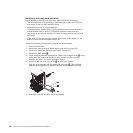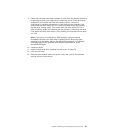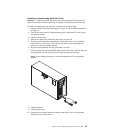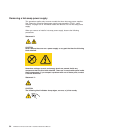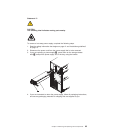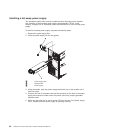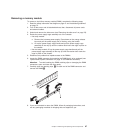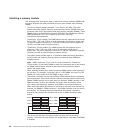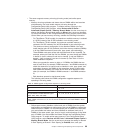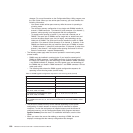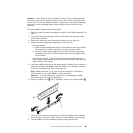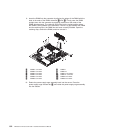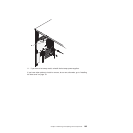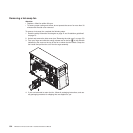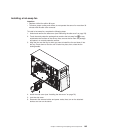
Installing a memory module
The following notes describe the types of dual inline memory modules (DIMMs) that
the server supports and other information that you must consider when installing
DIMMs:
v The server supports industry-standard, 1.8 V, 240-pin, 667 MHz, PC2-5300
double-data-rate 2 (DDR2), dynamic random-access memory (DRAM) with error
correcting code (ECC) fully buffered dual inline memory modules (DIMMs). These
DIMMs must be compatible with the latest DDR2 667 MHz DRAM fully buffered
DIMM specification. For a list of options for the server, see http://
www.lenovo.com/accessories.
v (ThinkServer TD100 models) The DIMM options that are supported for the server
are 512 MB, 1 GB , and 2 GB in x4 or x8 technology, single-rank or double-rank.
The server supports a minimum of 1 GB and a maximum of 32 GB (reduced to
16 GB in mirrored mode) of system memory.
v (ThinkServer TD100x models) The DIMM options that are supported for the
server are 1 GB, 2 GB, and 4 GB in x4 or x8 technology, single-rank or
double-rank. The server supports a minimum of 1 GB and a maximum of 48 GB
(reduced to 24 GB in mirrored mode) of system memory.
v The system board provides eight or 12 functional DIMM connectors (depending
on the model) and supports two-way memory interleaving when DIMMs are
installed in pairs.
Note: DIMM connectors 3, 6, 9, and 12 are not functional for ThinkServer
TD100 models. Do not install DIMMs in these four connectors and do not remove
the DIMM thermal baffles installed in these connectors unless you need to
replace the system board.
v When installing multiple pairs, always install the DIMMs with the most capacity in
the first slots. For example, if you had a pair of 1 GB DIMMs and a pair of 4 GB
DIMMs, you would install the 4 GB DIMMs in slots 1 and 4.
v The memory controller has four fully buffered DIMM channels that are organized
into two branches. Each branch has two channels and each channel controls two
DIMMs. DIMMs that are next to each other (for example, DIMM connector 1 and
DIMM connector 4) within the channels of a branch must be identical in size,
type, speed, and technology. However, the DIMMs in the connector above or
below each other within the channels of a branch do not have to be identical (for
example, the DIMMs in DIMM connector 1 and DIMM connector 2 do not have to
be identical). The following illustration shows how the memory controller is
organized into branches and channels with a pair of DIMMs installed in each
branch.
DIMM 2
DIMM 3
DIMM 1
DIMM 5
DIMM 6
DIMM 4
DIMM 8
DIMM 9
DIMM 7
DIMM 11
DIMM 12
DIMM 10
Memory Controller
Branch 0
Branch 1
Channel 0 Channel 1 Channel 2 Channel 3
v The server can operate in two major modes: mirroring and non-mirroring
(normal). The server can also operate in a single-channel mode when one DIMM
is installed.
98 ThinkServer TD100 and TD100x: Hardware Maintenance Manual



